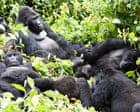
In a world where environmental conservation and development often intersect, recent events across the globe bring these issues into sharper focus. From the lush forests of the Democratic Republic of the Congo (DRC) to the majestic mountainous landscapes of Italy’s Brenta Dolomites, and further to the hydrological advancements in Northern Europe, the challenges and efforts to balance nature and human progress are both complex and critical.
The Democratic Republic of the Congo, known for its diverse ecosystems and rich biodiversity, is embarking on a bold yet contentious venture. The government has initiated a licensing round for oil and gas exploration across 52 sprawling fossil fuel blocks, potentially extending over half of the country’s expanse. These blocks encompass approximately 124 million hectares (306 million acres) of land and inland waters, regions recognized by environmental experts as critical carbon reserves and habitats for threatened species such as lowland gorillas and bonobos.
This decision, while aimed at economic development, poses significant concerns. It challenges conservation efforts designed to preserve these precious habitats, which also serve as vital lifelines for around 39 million people whose lives intertwine with the forest. The potential environmental upheaval underscores the complexities nations face when prioritizing economic advancement alongside ecological preservation. Thus, it invites a global dialogue on finding sustainable pathways that allow for economic growth without impending significant costs to biodiversity and local communities.
Meanwhile, in Italy’s Brenta Dolomites, nature’s serene beauty has been punctuated by a series of dramatic geological events. A succession of rockfalls has necessitated the evacuation of hundreds of hikers and tourists. Several trails have been temporarily closed following these incidents. Experts attribute these rock collapses to the thawing of permafrost—a consequence of increasing global temperatures, illustrating the expanding reach of the climate crisis even into alpine regions.
Visitors to areas like Cima Falkner have reported haunting sounds of crashing rocks, reminding us of Earth’s dynamic and sometimes volatile processes. These events serve as stark reminders of the need for climate action and the development of innovative strategies to manage and adapt to the changing geological dynamics in regions susceptible to such natural occurrences.
Further north, optimism emerges as significant strides are made towards enhancing resilience against environmental challenges. In Northern Europe, investments totaling 33.5 million euros are dedicated to mitigating flood risks through sustainable water management initiatives. These projects emphasize the importance of water security and quality services in supply and sanitation, viewing them as pillars of environmental justice, territorial coherence, and community resilience. The initiative represents a proactive approach to addressing the increasing instances of extreme weather conditions that have otherwise plagued various parts of Europe.
The President of the Coordination Commission for Regional Development (CCDR) remarked passionately about these efforts, highlighting how they embody a commitment to sustainable development while catering to immediate environmental needs. Such investments not only safeguard against potential disasters but also reinforce the importance of coherent planning in creating resilient communities.
Each of these stories from across the globe brings to light the intricate relationship humans share with their environments. The paths chosen by countries as they navigate the pressing demands of development and conservation underscore the evolving narrative of how we, as a global society, can achieve a harmonious balance. Initiatives focusing on sustainable development and climate adaption foster hope for preserving natural and human systems alike. Through careful planning and sincere efforts, there lies the potential not just to overcome current challenges, but also to pave the way for a thriving, connected world where both nature and humans flourish together.
Source: {link}
